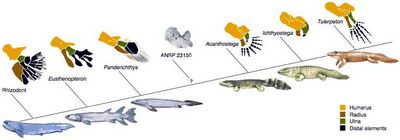
Panderichthys from HERE.
The pelvic fin and girdle of Panderichthys and the origin of tetrapod locomotion. 2005. C. A. Boisvert. Nature 438, 1145-1147.
Abstract: One of the most marked transformations in the vertebrate transition to land was that of fins to limbs. This transformation involved not only the generation of morphological novelties (digits, sacrum) but also a shift in locomotory dominance from the pectoral to the pelvic appendage. Despite its importance, the transformation from pelvic fin to hindlimb is the least studied and least well-documented part of this transformation, which is bracketed by the osteolepiform Eusthenopteron and the early tetrapods Ichthyostega and Acanthostega, but is not directly illuminated by any intermediate form. Panderichthys is the closest tetrapod relative currently represented by complete fossils, but its pelvic fin skeleton has not been described.
Here, I present the only known articulated pelvic fin endoskeleton and associated partial pelvis of Panderichthys. The pelvic girdle is even less tetrapod-like than that of the osteolepiform Eusthenopteron, but the pelvic fin endoskeleton shares derived characteristics with basal tetrapods despite being more primitive than the pectoral fin of Panderichthys. The evolution of tetrapod locomotion appears to have passed through a stage of body-flexion propulsion, in which the pelvic fins played a relatively minor anchoring part, before the emergence of hindlimb-powered propulsion in the interval between Panderichthys and Acanthostega.

Illustration from Shubin et al.(2004) Science 304:90-93 & © Science & taken from the excellent site, Pharyngula.org. (Click to enlarge)